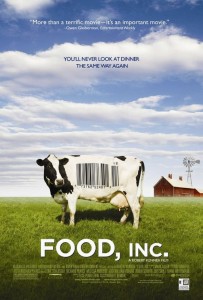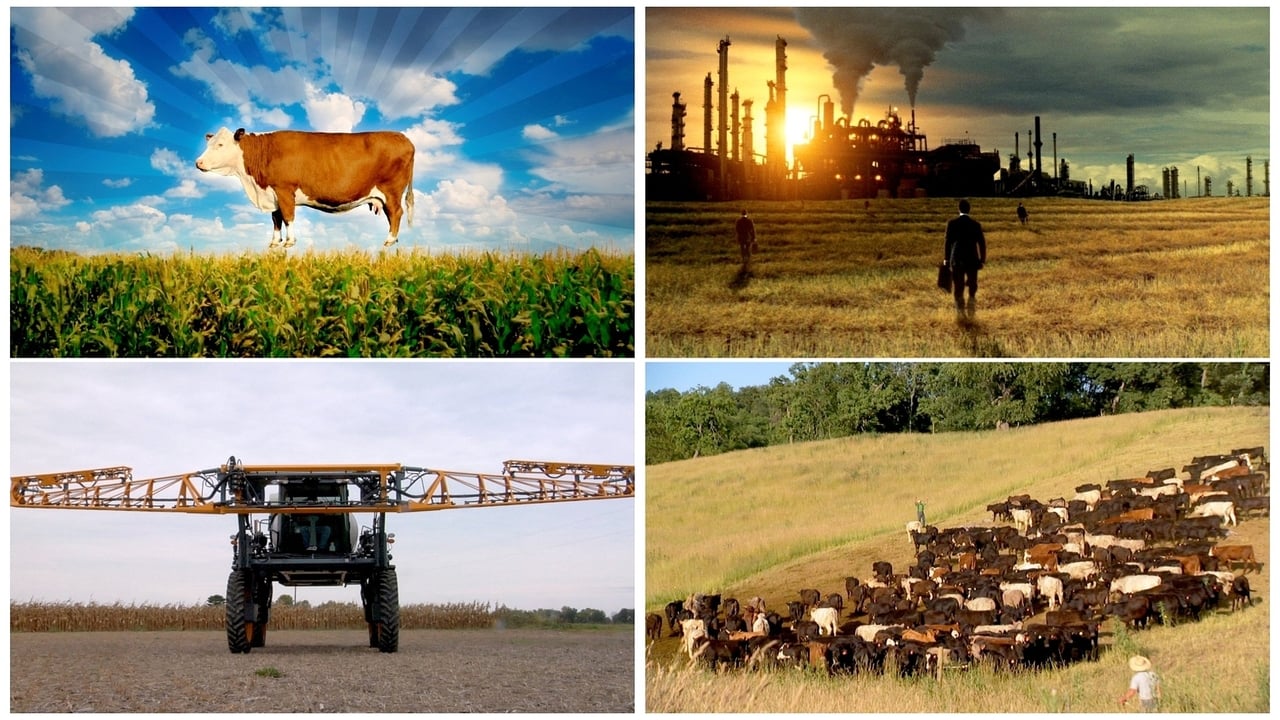
Last night my friend Dave and I headed off to the theater to see the documentary Food, Inc. Filmmaker Robert Kenner gives us a tour of the nation’s food industry in hopes of exposing elements most consumers have been kept from knowing.
Food, Inc. has an altruistic goal from the outset of the film. It starts by explaining how the food we eat has changed so dramatically in the last 50 years that humanity really has no other period to compare it to. The story is broken up into small segments that come at you a bit like a book with chapters. Each chapter explains its core supposition and provides us with evidence it hopes convinces us of its main conclusions.
Food, Inc. is spotty in this regard. The chapters often break just as you’re getting interested and take you off in another direction. Sometimes the two segments meld well and at other times they don’t. Making things more challenging is that the first third of the movie is a bit slow and does a poor job of really convincing the viewer of much. Oh, we’re presented with anecdotal evidence. There are video images that make you cringe but some of it is questionable in its ability to convince us of the bigger picture.
For example, we’re introduced to the mother and grandmother of Kevin Kowalcyk. Kevin died in 2001 at the age of two after eating hamburger contaminated with a specific strain of E-coli. My problem with this is that there’s no way to not feel sympathy for the Kowalcyk’s. Using them in this manner distracts us from the raw data. We’re supposed to just feel their heartache and effect a change. To me it feels like unnecessary manipulation. Just give us the facts and keep the anecdotal evidence out of the film or leave it until after you prove the main points without it.
This is not to say there isn’t compelling information in the movie. There certainly is quite a bit of it. The movie does a wonderful job of explaining how the origins of all these changes came about from the efforts of one well-meaning company and the drive to meet its new, novel needs.
Along the way we also get to meet the CEO of Stonyfield Farms whose products prove that you can have organic products that also make a solid profit and can lead their field in demand.
We also get a hint of a disturbing change to our own freedom of speech. In some states, we’re told, it’s illegal to criticize the food industry. Oprah Winfrey is given as the one example where, given all her riches, she was able to win out over industry-driven laws when she so famously said that Mad Cow Disease had gotten her to stop eating beef.
It also does a fantastic job in an area or two. It tells us the story of chemical company Monsanto that now owns a near-monopoly on all soy production in this country. They were able to change the laws so that genetically altered seeds could be patented and they defend this patent to radical extremes. Growers that use such seeds are, for example, prohibited from saving the seeds of the plants that result from them to use for the following growing season. They instead have to buy new seeds each year. If your traditional soy plants happen to border those of a farmer that uses Monsanto seeds then it’s almost inevitable that nature will dictate that your crop becomes infected by the altered species and then you’ll be sued by Monsanto for patent infringement. More disturbing is that Monsanto keeps lists of every soy farmer and related peripheral players. The lists are used to drive out anyone involved in any activity that might keep farmers from using non-Monsanto soy seeds.
Another point well made is that, back before this revolution a typical burger had, essentially, a 1-to-1 relationship of burger to cow. In other words, earlier generations would go to a butcher who would take a slab of beef and create ground beef from that slab. The result was a burger made up of meat from a single cow. The problem with this approach is that it’s slow and results in unreliable tastes. One cow can taste entirely different from another and people don’t like unreliable results. Today the average burger includes meat from over a thousand cows. This results in a very dependable taste but the downside is fairly obvious. Each burger now has to deal with the issues of a thousand cows instead of just one. The odds of infection per burger goes up dramatically.
There’s one segment of the movie that I need to mention that’s intended to provide solid evidence for organic meat farming and yet the way it’s presented turns it into one of its biggest failures. The movie introduces us to an organic farmer who raises free-ranging cattle, naturally raised chickens, pigs and more. The point is to show us that organic is so obviously better—for us, the animals, the environment, the economy, etc.
The problem is that we see several shots of this farmer killing his chickens en masse along with the, seemingly, heartless cleaning process. He’s telling us how sanitary it all is while, on-screen, it all looks filthy to the uninformed. The main reason this fails so terribly is that we rarely ever see the non-organic side. We only glimpse hints of it. One disturbing scene involving the death of plant-processed pigs is, ultimately, confusing. I’m still not sure what I saw happen. We see pigs go in. We hear squeals. We see dead pigs come out. Contrast that with the organic farmer where we see them physically grab a chicken, stuff it into a funnel, head facing down and then watch as its throat is cut and the blood drips into overflowing vats on the ground. We see this repeated for several chickens. The end result is a revulsion to all such killing. Maybe this is what the movie really wants to convey but it works against the stated message.
The fact is that I believe humans are carnivores. We eat meat because meat tastes good to us. What has changed is that most of us no longer have any connection to old-style farming. My great-grandfather would have thought nothing of creating a meal of a chicken in his back yard and all that’s involved. We’ve been so removed from the process that seeing any part of it disgusts us. Maybe we’re finally at a cross-roads and technology might be able to give us a win-win here. We want the meat but we don’t want the guilt. This, to me, is a different story for a different movie.
The point is that we now live under a food system that’s been turned entirely upside down. Products we grow in the ground that are good for us are now dramatically more expensive than those that aren’t. Processed foods go through so much technology and research and yet, with subsidies, these products end up forcing people to choose what’s bad for them. Why? Profit of course. There’s more money to be made from potato chips than from potatoes.
The best part of the film is the final analysis that makes the point that we all have a voice in this and that our voice is heard. Wal-Mart is now selling organic products because their consumers demand it. We’re told we all have a vote, three times every day, and to use it to demand change. I guess the best result of all is that the movie has made me once again consider what I’m eating. Maybe this time it’ll have a real impact. Then again I came home and ate two packs of Tastykake’s.


